21 November 2025
Weekly Market View
Tech sector clarity amidst the data fog
As a selloff in the tech sector deepens on valuations concerns, we believe it’s opportune to focus on the sector’s strong revenue and earnings. The sector’s AI-driven growth prospects should offset near-term uncertainty caused by a potential delay in Fed rate cuts.
A stronger-than-expected US jobs report for September, delayed release of October data and above-target inflation have led many Fed policymakers to question the need for another rate cut on 10 December, raising market volatility.
We expect the Fed to eventually cut rates again by Q1 2026 as a rising jobless rate and alternative data suggests the job market is slowing.
Strong corporate earnings fundamentals and eventual Fed rate cuts sustain the case for an economic soft-landing. This suggests the pullback in risk assets, especially in tech sector equities in the US and China, is presenting opportunities to add exposure.
Opportunity to add US, China tech sector equities – strong AI-led revenue, earnings
Stay with 5-7-year maturity in US bonds – balance between yield and inflation risks
USD/JPY upside capped – BoJ intervention risk, eventual BoJ rate hike
Charts of the week: Solid tech outlook vs. delayed rate cuts
The tech sector’s robust AI-driven earnings outlook is likely to offset worries about valuation and likely delayed Fed cuts
Market estimates of Fed median rate for end-2025 and 2026*
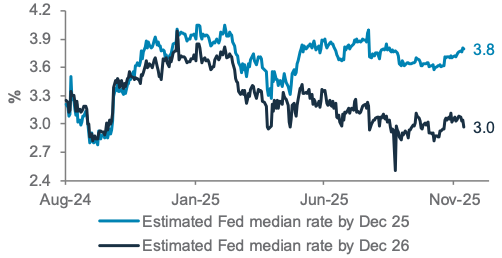
Consensus 2025-26 earnings estimates of US equity sectors
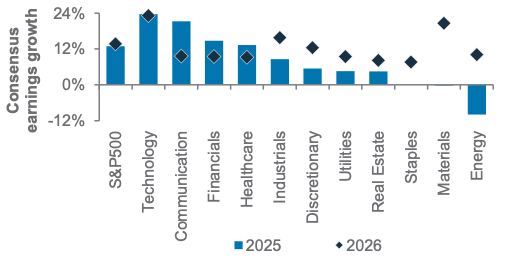
Source: Bloomberg, LSEG I/B/E/S, Standard Chartered; *Based on money markets
Editorial
Tech sector clarity amidst the data fog
Strategy summary: As a selloff in the tech sector deepens on valuations concerns, we believe it’s opportune to focus on the sector’s strong revenue and earnings, headlined this week by semiconductor industry leader Nvidia. The sector’s AI-driven growth prospects should offset near-term uncertainty caused by a potential delay in Fed rate cuts. A stronger-than-expected US jobs report for September, delayed release of October data and above-target inflation have led many Fed policymakers to question the need for another rate cut on 10 December, raising market volatility.
We expect the Fed to eventually cut rates again by Q1 next year as a rising jobless rate and alternative data suggests the job market continues to slow. Strong corporate earnings fundamentals and eventual Fed rate cuts sustain the case for an economic soft-landing. This suggests the pullback in risk assets, especially in tech sector equities in the US and China, is presenting opportunities to add exposure.
Strong jobs data, data fog raise doubts over a December Fed rate cut. The delayed September jobs report showed a stronger-than-expected 119,000 rise in US payrolls. The US will not release jobs data for October due to a halt in surveys during the government shutdown. The release of November’s data will be delayed after the next Fed policy meeting on 10 December. The prolonged US data fog and the strong September report is lowering the prospect of another Fed rate cut next month, as signalled by a rising number of policymakers and minutes from the Fed’s last meeting, released this week.
We believe the Fed will eventually cut rates by Q1 2026 as private sector data shows falling job openings, slowing wage growth and a surge in layoff announcements. Also, the jobless rate in September rose to a four-year high of 4.4%. Hence, we see any rise in the US 10-year government bond yield towards 4.20-4.25% as an opportunity to add to high quality bonds, preferably in the 5-7-year maturity range. We retain our 12-month target on the US 10-year yield at 3.75-4.0% and remain on watch for any signs of further job market weakness.
A confidence boost from tech sector. Semiconductor maker Nvidia’s strong forward guidance this week should eventually help ease a key headwind facing risk assets lately – the sector’s elevated valuations. Nvidia’s guidance mirrors robust order books, earnings growth and attractive profit margins for the semiconductor sector. We believe these robust fundamentals support relatively high sector valuations. Meanwhile, China’s sustained property market downturn is raising the chance of more targeted stimulus. China’s consumer and tech sectors are likely to benefit the most from any policy boost. (see page 4).
Japan outlook clouded by fiscal uncertainty; prefer Asia ex-Japan. Japan’s stocks have fallen c. 6% in USD terms from their recent peak, USD/JPY has surged to a 10-month high and the 30-year government yield has set a new record high as the government’s proposed fiscal boost, the largest since the pandemic, raises concerns about fiscal sustainability. The spat with China over Taiwan is adding to the uncertainty. Given the uncertainty, we prefer Asia ex-Japan equities (see page 5).
Rising chance of a BoJ intervention to stem the yen’s slide. The market reaction to the government’s fiscal stimulus suggests investors are finally drawing a line in the sand. A weaker yen is likely to complicate the authorities’ plan to stem rising inflation expectations. Yet, there are mixed messages on the timing of the next BoJ rate hike, with a government advisor suggesting a hike in March, while a BoJ board member suggested the need for a hike next month to stem the yen’s slide. We see rising prospects of a BoJ intervention around 158-160 curbing further USD/JPY upside (see page 5).
Indian equities turning around: There are signs of a revival in Indian equities after this year’s underperformance. Front-loading of fiscal stimulus and rate cuts this year, in response to US tariffs, are likely to revive domestic consumption, potentially triggering corporate earnings upgrades in 2026. India’s valuation premium vs. regional peers has narrowed and investor positioning remains low. Any potential trade agreement with the US is likely to revive foreign investor sentiment.
— Rajat Bhattacharya
The weekly macro balance sheet
Our weekly net assessment: : On balance, we see the past week’s data and policy as negative for risk assets in the near-term
(+) factors: Robust US manufacturing activity; easing trade tensions
(-) factors: Cautious Fed; US credit risks, China property downturn

US job creation in September was better than expected but previous month’s data was revised down to a contraction; the jobless rate also rose to 4.4%, the highest level since October 2021
US non-farm payrolls and unemployment rate
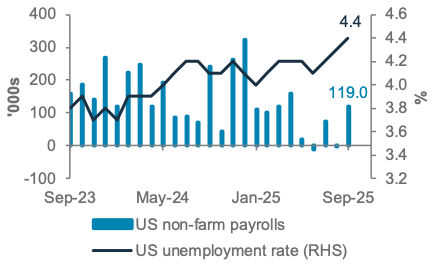
UK headline consumer inflation rate fell for the first time in five months, while core inflation fell to 3.4%, raising the prospect of a BoE rate cut
UK headline and core consumer inflation
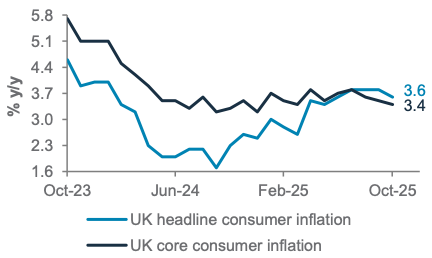
China’s new-home prices saw the steepest monthly decline in a year during October 2025, raising the chance of a more targeted stimulus
China’s new-home prices across 70 cities
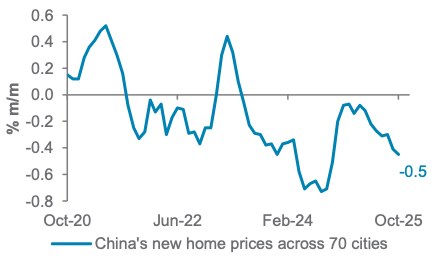
Top client questions
What are the key takeaways from the US semiconductor industry’s earnings season?
Our view: We believe the momentum in AI-related investment remains strong. The current equity market pullback is a good opportunity to add exposure to the US technology sector.
Rationale: The semiconductor industry’s Q3 earnings beat consensus expectations. Forward looking guidance has also been strong, driven by demand for advanced chips used in AI applications. Major internet companies and cloud-infrastructure providers, which generate significant cashflows in their respective businesses, continue to order significant amount of such chips, leading to demand exceeding available supply.
As semiconductor technology continues to advance, needing faster processing speeds and more efficient power requirements, the development and production of the next generation of advanced chips will be crucial to sustain revenue growth in the semiconductor industry. US semiconductor industry earnings are expected to grow by 42% in 2025 and 40% in 2026. Valuations are elevated, but not at extreme levels.
— Fook Hien Yap, Senior Investment Strategist
The US semiconductor industry is likely to deliver strong earnings growth, supporting technology sector equities’ outperformance
Consensus expectations for 2025 and 2026 earnings growth for the US technology sector and its sub-industries
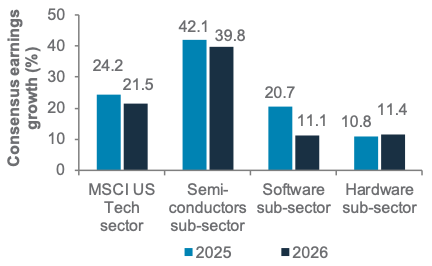
Have China’s tech and e-commerce industry’s latest earnings lived up to expectations?
Our View: China’s growth sector delivered strong earnings. We are Overweight Chinese equities within Asia ex-Japan. Pullback in growth stocks provides an opportunity to add exposure.
Rationale: China growth stocks delivered solid results in Q3 2025, with the IT sector showing robust earnings growth at 58%. In contrast, Consumer Discretionary posted a modest 9% increase, while Communication Services declined by 5%, both underperforming the 12% rise in the broader MSCI China index as of 20 November (Source: Bloomberg). Deflationary pressures and prolonged price competition both weighed upon margins.
While the pullback in global equities has been dampening investor sentiment, we remain Overweight on these sectors: 1) Policy tailwinds: Government “anti-involution” measures aimed at curbing excessive price competition should bolster corporate margins; potential property stimulus package should help; 2) Tech investment cycle: Ongoing capital expenditure and innovation in AI across major technology stocks to achieve “technological self-reliance”; 3) Attractive valuations: Chinese tech stocks continue to trade at a discount relative to Developed Market peers. Looking ahead, 12-month forward EPS growth for the Hang Seng Tech index of 41% provides a solid foundation for continued valuation rerating.
— Michelle Kam, CFA, Investment Strategist
Resilient earnings outlook across China growth sectors is positive for the Hang Seng Tech index
12-month forward EPS growth for Hang Seng Tech index

Top client questions (cont’d)
What are the investment implications of Japan’s new government policies?
Our View: Long term JGB yields are likely to climb higher if the government persists with its plan for a large fiscal stimulus, with increasing downside risks to Japanese equities. However, rising risks of a BoJ rate hike and currency market intervention means USD/JPY appears overstretched at current levels.
Rationale: USD/JPY broke above 155, driven by Japan PM’s plans for a large fiscal stimulus, a firmer USD and some dovish comments from the BoJ. However, we expect USD/JPY to be capped. In the US, October Fed meeting minutes showed many officials were unwilling to cut in December due to a lack of progress on inflation, limited labour data and heightened uncertainty due to the government shutdown. This pushed the USD higher as markets trimmed December rate cut expectations. However, the US unemployment rate rose in September, leading to consolidation in the USD index (DXY) around 100. In Japan, policy signals have become more mixed. Japan PM’s panel member Kataoka noted the BoJ is unlikely to hike before March, though BoJ board member Koeda suggested a rate hike could happen as early as next month. Meanwhile, the rapid JPY depreciation raises intervention risks. On technical charts, 158–160 is a significant resistance zone. We expect USD/JPY to consolidate within this band rather than break meaningfully higher.
For bonds, long-term Japanese government bond (JGB) yields are rising on the back of news that PM Takaichi’s proposed fiscal package will be larger than JPY 17tn, which is more expansionary relative to market expectations. The 10-year JGB yield rose to 1.83%, a level last seen just before the global financial crisis. The BoJ may intervene should the rise in yield become too aggressive. The market is expecting a BoJ rate hike at the March 2026 meeting. We see further steepening in the JGB bond yield curve from here.
Meanwhile, Japan’s solid Q3 corporate earnings, driven by resilient margins, and constructive forward earnings outlook, has supported this year’s equities rally. Corporate governance reforms continue to be a positive catalyst, with the announced value of share buyback YTD exceeding the FY 2024 total. However, we see increasing downside risks in the near-term from escalating geopolitical tensions with China, particularly through the potential loss of tourism revenue and supply chain disruptions. Furthermore, the valuation of Japanese equities appears less compelling – the Nikkei 225 index now trades at around +1.5 standard deviation above its 5-year average, which may limit near-term upside potential.
— Ray Heung, Senior Investment Strategist
Iris Yuen, Investment Strategist
Jason Wong, Equity Analyst
USD/JPY resistance zone at 158-160; further upside is likely capped amid BoJ intervention risk
USD/JPY and technical support/resistance levels

Japan’s 10-year bond yield rose sharply on a potentially larger-than-expected fiscal stimulus. Markets expect a BoJ rate hike in March 2026
10-year JGB yield. Market implied number of 25 bps BoJ rate hike/s by Dec 2025 and Mar 2026

Nikkei 225 index valuation appears less compelling, which may limit near-term upside potential
Nikkei 225 index 12-month forward P/E ratio

Top client questions (cont’d)
Are you changing your US rates outlook after September’s payrolls data and minutes from the Fed’s last meeting?
Our view: The Fed’s messaging indicates a risk of fewer rate cuts than previously anticipated. Investors should rebalance towards 5-7 year maturities as the US 10-year rate approaches the lower bound of our 3-month target range of 4.00-4.25%. The 5-7-year maturity bucket offers the best balance between yields versus fiscal and inflation risks.
Rationale: The minutes from October’s Fed policy meeting suggested a divided committee, with some members advocating for more easing if labour market conditions weaken further, while others expressed concerns about persistent inflation and favour caution. Consequently, the odds of a rate cut in December have dropped from almost 100% in mid-October to approximately 30%.
So far, limited data releases due to the government shutdown conveyed an impression of resilience in economic activity, despite some weakness in the job market. For instance, the ADP payroll data indicated a downturn in job growth for October. The delayed September non-farm payroll was better than expected but with significant revision down to job gains in earlier months. Meanwhile, the unemployment rate rose to a four-year high of 4.4% in September. On average, the job growth trend is slowing down. Economic indicators such as durable goods orders, Empire State manufacturing, and construction spending suggest continued economic resilience.
The market has priced in fewer rate cuts than before, but we believe that the weakness in unemployment will lead to more Fed rate cuts next year, especially in Q1.
— Ray Heung, Senior Investment Strategist
Fed’s projection of its target policy rate suggests less rate cuts than that implied by money markets
Fed funds rates – Dot-plot median projections for end-2026 vs market implied estimates

Market performance summary*

Our 12-month asset class views at a glance
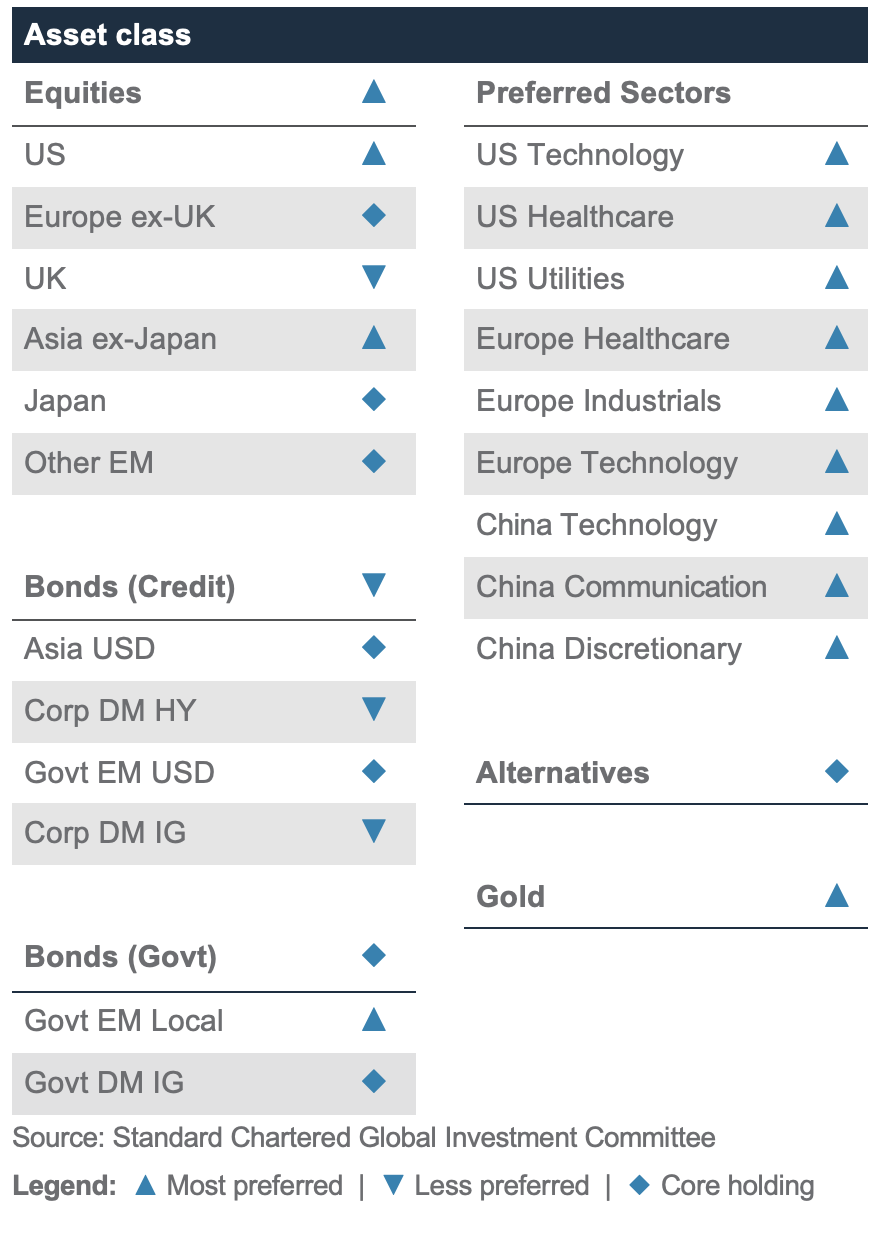
Economic and market calendar

The S&P500 has next interim resistance at 6,795
Technical indicators for key markets as of 20 November close
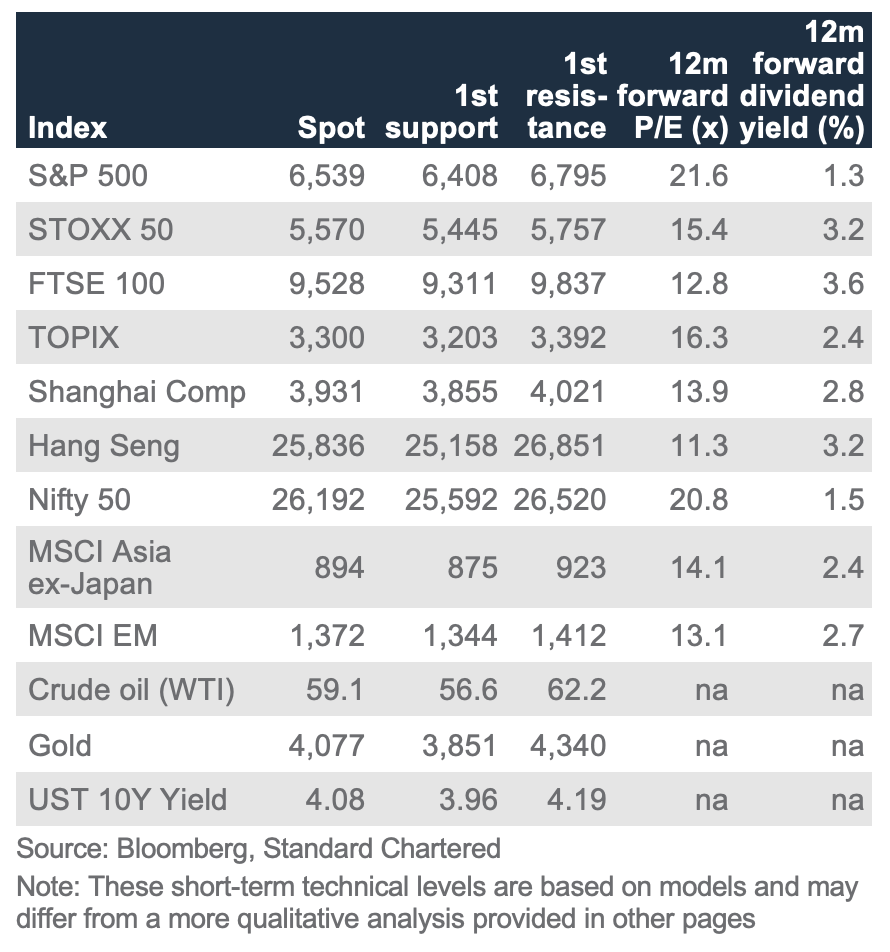
Investor diversity has normalised across asset classes
Our proprietary market diversity indicators as of 20 Nov close


Disclosure
This document is confidential and may also be privileged. If you are not the intended recipient, please destroy all copies and notify the sender immediately. This document is being distributed for general information only and is subject to the relevant disclaimers available at our Standard Chartered website under Regulatory disclosures. It is not and does not constitute research material, independent research, an offer, recommendation or solicitation to enter into any transaction or adopt any hedging, trading or investment strategy, in relation to any securities or other financial instruments. This document is for general evaluation only. It does not take into account the specific investment objectives, financial situation or particular needs of any particular person or class of persons and it has not been prepared for any particular person or class of persons. You should not rely on any contents of this document in making any investment decisions. Before making any investment, you should carefully read the relevant offering documents and seek independent legal, tax and regulatory advice. In particular, we recommend you to seek advice regarding the suitability of the investment product, taking into account your specific investment objectives, financial situation or particular needs, before you make a commitment to purchase the investment product. Opinions, projections and estimates are solely those of SC at the date of this document and subject to change without notice. Past performance is not indicative of future results and no representation or warranty is made regarding future performance. The value of investments, and the income from them, can go down as well as up, and you may not recover the amount of your original investment. You are not certain to make a profit and may lose money. Any forecast contained herein as to likely future movements in rates or prices or likely future events or occurrences constitutes an opinion only and is not indicative of actual future movements in rates or prices or actual future events or occurrences (as the case may be). This document must not be forwarded or otherwise made available to any other person without the express written consent of the Standard Chartered Group (as defined below). Standard Chartered Bank is incorporated in England with limited liability by Royal Charter 1853 Reference Number ZC18. The Principal Office of the Company is situated in England at 1 Basinghall Avenue, London, EC2V 5DD. Standard Chartered Bank is authorised by the Prudential Regulation Authority and regulated by the Financial Conduct Authority and Prudential Regulation Authority. Standard Chartered PLC, the ultimate parent company of Standard Chartered Bank, together with its subsidiaries and affiliates (including each branch or representative office), form the Standard Chartered Group. Standard Chartered Private Bank is the private banking division of Standard Chartered. Private banking activities may be carried out internationally by different legal entities and affiliates within the Standard Chartered Group (each an “SC Group Entity”) according to local regulatory requirements. Not all products and services are provided by all branches, subsidiaries and affiliates within the Standard Chartered Group. Some of the SC Group Entities only act as representatives of Standard Chartered Private Bank and may not be able to offer products and services or offer advice to clients.
Copyright © 2025, Accounting Research & Analytics, LLC d/b/a CFRA (and its affiliates, as applicable). Reproduction of content provided by CFRA in any form is prohibited except with the prior written permission of CFRA. CFRA content is not investment advice and a reference to or observation concerning a security or investment provided in the CFRA SERVICES is not a recommendation to buy, sell or hold such investment or security or make any other investment decisions. The CFRA content contains opinions of CFRA based upon publicly-available information that CFRA believes to be reliable and the opinions are subject to change without notice. This analysis has not been submitted to, nor received approval from, the United States Securities and Exchange Commission or any other regulatory body. While CFRA exercised due care in compiling this analysis, CFRA, ITS THIRD-PARTY SUPPLIERS, AND ALL RELATED ENTITIES SPECIFICALLY DISCLAIM ALL WARRANTIES, EXPRESS OR IMPLIED, INCLUDING, BUT NOT LIMITED TO, ANY WARRANTIES OF MERCHANTABILITY OR FITNESS FOR A PARTICULAR PURPOSE OR USE, to the full extent permitted by law, regarding the accuracy, completeness, or usefulness of this information and assumes no liability with respect to the consequences of relying on this information for investment or other purposes. No content provided by CFRA (including ratings, credit-related analyses and data, valuations, model, software or other application or output therefrom) or any part thereof may be modified, reverse engineered, reproduced or distributed in any form by any means, or stored in a database or retrieval system, without the prior written permission of CFRA, and such content shall not be used for any unlawful or unauthorized purposes. CFRA and any third-party providers, as well as their directors, officers, shareholders, employees or agents do not guarantee the accuracy, completeness, timeliness or availability of such content. In no event shall CFRA, its affiliates, or their third-party suppliers be liable for any direct, indirect, special, or consequential damages, costs, expenses, legal fees, or losses (including lost income or lost profit and opportunity costs) in connection with a subscriber’s, subscriber’s customer’s, or other’s use of CFRA’s content.
Market Abuse Regulation (MAR) Disclaimer
Banking activities may be carried out internationally by different branches, subsidiaries and affiliates within the Standard Chartered Group according to local regulatory requirements. Opinions may contain outright “buy”, “sell”, “hold” or other opinions. The time horizon of this opinion is dependent on prevailing market conditions and there is no planned frequency for updates to the opinion. This opinion is not independent of Standard Chartered Group’s trading strategies or positions. Standard Chartered Group and/or its affiliates or its respective officers, directors, employee benefit programmes or employees, including persons involved in the preparation or issuance of this document may at any time, to the extent permitted by applicable law and/or regulation, be long or short any securities or financial instruments referred to in this document or have material interest in any such securities or related investments. Therefore, it is possible, and you should assume, that Standard Chartered Group has a material interest in one or more of the financial instruments mentioned herein. Please refer to our Standard Chartered website under Regulatory disclosures for more detailed disclosures, including past opinions/ recommendations in the last 12 months and conflict of interests, as well as disclaimers. A covering strategist may have a financial interest in the debt or equity securities of this company/issuer. All covering strategist are licensed to provide investment recommendations under Monetary Authority of Singapore or Hong Kong Monetary Authority. This document must not be forwarded or otherwise made available to any other person without the express written consent of Standard Chartered Group.
Sustainable Investments
Any ESG data used or referred to has been provided by Morningstar, Sustainalytics, MSCI or Bloomberg. Refer to 1) Morningstar website under Sustainable Investing, 2) Sustainalytics website under ESG Risk Ratings, 3) MCSI website under ESG Business Involvement Screening Research and 4) Bloomberg green, social & sustainability bonds guide for more information. The ESG data is as at the date of publication based on data provided, is for informational purpose only and is not warranted to be complete, timely, accurate or suitable for a particular purpose, and it may be subject to change. Sustainable Investments (SI): This refers to funds that have been classified as ‘ESG Intentional Investments – Overall’ by Morningstar. SI funds have explicitly stated in their prospectus and regulatory filings that they either incorporate ESG factors into the investment process or have a thematic focus on the environment, gender diversity, low carbon, renewable energy, water or community development. For equity, it refers to shares/stocks issued by companies with Sustainalytics ESG Risk Rating of Low/Negligible. For bonds, it refers to debt instruments issued by issuers with Sustainalytics ESG Risk Rating of Low/Negligible, and/or those being certified green, social, sustainable bonds by Bloomberg. For structured products, it refers to products that are issued by any issuer who has a Sustainable Finance framework that aligns with Standard Chartered’s Green and Sustainable Product Framework, with underlying assets that are part of the Sustainable Investment universe or separately approved by Standard Chartered’s Sustainable Finance Governance Committee. Sustainalytics ESG risk ratings shown are factual and are not an indicator that the product is classified or marketed as “green”, “sustainable” or similar under any particular classification system or framework.
Country/Market Specific Disclosures
Bahrain: This document is being distributed in Bahrain by Standard Chartered Bank, Bahrain Branch, having its address at P.O. 29, Manama, Kingdom of Bahrain, is a branch of Standard Chartered Bank and is licensed by the Central Bank of Bahrain as a conventional retail bank. Botswana: This document is being distributed in Botswana by, and is attributable to, Standard Chartered Bank Botswana Limited which is a financial institution licensed under the Section 6 of the Banking Act CAP 46.04 and is listed in the Botswana Stock Exchange. Brunei Darussalam: This document is being distributed in Brunei Darussalam by, and is attributable to, Standard Chartered Bank (Brunei Branch) | Registration Number RFC/61 and Standard Chartered Securities (B) Sdn Bhd | Registration Number RC20001003. Standard Chartered Bank is incorporated in England with limited liability by Royal Charter 1853 Reference Number ZC18. Standard Chartered Securities (B) Sdn Bhd is a limited liability company registered with the Registry of Companies with Registration Number RC20001003 and licensed by Brunei Darussalam Central Bank as a Capital Markets Service License Holder with License Number BDCB/R/CMU/S3-CL and it is authorised to conduct Islamic investment business through an Islamic window. China Mainland: This document is being distributed in China by, and is attributable to, Standard Chartered Bank (China) Limited which is mainly regulated by National Financial Regulatory Administration (NFRA), State Administration of Foreign Exchange (SAFE), and People’s Bank of China (PBOC). Hong Kong: In Hong Kong, this document, except for any portion advising on or facilitating any decision on futures contracts trading, is distributed by Standard Chartered Bank (Hong Kong) Limited (“SCBHK”), a subsidiary of Standard Chartered PLC. SCBHK has its registered address at 32/F, Standard Chartered Bank Building, 4-4A Des Voeux Road Central, Hong Kong and is regulated by the Hong Kong Monetary Authority and registered with the Securities and Futures Commission (“SFC”) to carry on Type 1 (dealing in securities), Type 4 (advising on securities), Type 6 (advising on corporate finance) and Type 9 (asset management) regulated activity under the Securities and Futures Ordinance (Cap. 571) (“SFO”) (CE No. AJI614). The contents of this document have not been reviewed by any regulatory authority in Hong Kong and you are advised to exercise caution in relation to any offer set out herein. If you are in doubt about any of the contents of this document, you should obtain independent professional advice. Any product named herein may not be offered or sold in Hong Kong by means of any document at any time other than to “professional investors” as defined in the SFO and any rules made under that ordinance. In addition, this document may not be issued or possessed for the purposes of issue, whether in Hong Kong or elsewhere, and any interests may not be disposed of, to any person unless such person is outside Hong Kong or is a “professional investor” as defined in the SFO and any rules made under that ordinance, or as otherwise may be permitted by that ordinance. In Hong Kong, Standard Chartered Private Bank is the private banking division of SCBHK, a subsidiary of Standard Chartered PLC. Ghana: Standard Chartered Bank Ghana Limited accepts no liability and will not be liable for any loss or damage arising directly or indirectly (including special, incidental or consequential loss or damage) from your use of these documents. Past performance is not indicative of future results and no representation or warranty is made regarding future performance. You should seek advice from a financial adviser on the suitability of an investment for you, taking into account these factors before making a commitment to invest in an investment. To unsubscribe from receiving further updates, please send an email to feedback.ghana@sc.com. Please do not reply to this email. Call our Priority Banking on 0302610750 for any questions or service queries. You are advised not to send any confidential and/or important information to Standard Chartered via e-mail, as Standard Chartered makes no representations or warranties as to the security or accuracy of any information transmitted via e-mail. Standard Chartered shall not be responsible for any loss or damage suffered by you arising from your decision to use e-mail to communicate with the Bank. India: This document is being distributed in India by Standard Chartered in its capacity as a distributor of mutual funds and referrer of any other third party financial products. Standard Chartered does not offer any ‘Investment Advice’ as defined in the Securities and Exchange Board of India (Investment Advisers) Regulations, 2013 or otherwise. Services/products related securities business offered by Standard Charted are not intended for any person, who is a resident of any jurisdiction, the laws of which imposes prohibition on soliciting the securities business in that jurisdiction without going through the registration requirements and/or prohibit the use of any information contained in this document. Indonesia: This document is being distributed in Indonesia by Standard Chartered Bank, Indonesia branch, which is a financial institution licensed and supervised by Otoritas Jasa Keuangan (Financial Service Authority) and Bank Indonesia. Jersey: In Jersey, Standard Chartered Private Bank is the Registered Business Name of the Jersey Branch of Standard Chartered Bank. The Jersey Branch of Standard Chartered Bank is regulated by the Jersey Financial Services Commission. Copies of the latest audited accounts of Standard Chartered Bank are available from its principal place of business in Jersey: PO Box 80, 15 Castle Street, St Helier, Jersey JE4 8PT. Standard Chartered Bank is incorporated in England with limited liability by Royal Charter in 1853 Reference Number ZC 18. The Principal Office of the Company is situated in England at 1 Basinghall Avenue, London, EC2V 5DD. Standard Chartered Bank is authorised by the Prudential Regulation Authority and regulated by the Financial Conduct Authority and Prudential Regulation Authority. The Jersey Branch of Standard Chartered Bank is also an authorised financial services provider under license number 44946 issued by the Financial Sector Conduct Authority of the Republic of South Africa. Jersey is not part of the United Kingdom and all business transacted with Standard Chartered Bank, Jersey Branch and other SC Group Entity outside of the United Kingdom, are not subject to some or any of the investor protection and compensation schemes available under United Kingdom law. Kenya: This document is being distributed in Kenya by and is attributable to Standard Chartered Bank Kenya Limited. Investment Products and Services are distributed by Standard Chartered Investment Services Limited, a wholly owned subsidiary of Standard Chartered Bank Kenya Limited that is licensed by the Capital Markets Authority in Kenya, as a Fund Manager. Standard Chartered Bank Kenya Limited is regulated by the Central Bank of Kenya. Malaysia: This document is being distributed in Malaysia by Standard Chartered Bank Malaysia Berhad (“SCBMB”). Recipients in Malaysia should contact SCBMB in relation to any matters arising from, or in connection with, this document. This document has not been reviewed by the Securities Commission Malaysia. The product lodgement, registration, submission or approval by the Securities Commission of Malaysia does not amount to nor indicate recommendation or endorsement of the product, service or promotional activity. Investment products are not deposits and are not obligations of, not guaranteed by, and not protected by SCBMB or any of the affiliates or subsidiaries, or by Perbadanan Insurans Deposit Malaysia, any government or insurance agency. Investment products are subject to investment risks, including the possible loss of the principal amount invested. SCBMB expressly disclaim any liability and responsibility for any loss arising directly or indirectly (including special, incidental or consequential loss or damage) arising from the financial losses of the Investment Products due to market condition. Nigeria: This document is being distributed in Nigeria by Standard Chartered Bank Nigeria Limited (SCB Nigeria), a bank duly licensed and regulated by the Central Bank of Nigeria. SCB Nigeria accepts no liability for any loss or damage arising directly or indirectly (including special, incidental or consequential loss or damage) from your use of these documents. You should seek advice from a financial adviser on the suitability of an investment for you, taking into account these factors before making a commitment to invest in an investment. To unsubscribe from receiving further updates, please send an email to clientcare.ng@sc.com requesting to be removed from our mailing list. Please do not reply to this email. Call our Priority Banking on 02 012772514 for any questions or service queries. SCB Nigeria shall not be responsible for any loss or damage arising from your decision to send confidential and/or important information to Standard Chartered via e-mail. SCB Nigeria makes no representations or warranties as to the security or accuracy of any information transmitted via e-mail. Pakistan: This document is being distributed in Pakistan by, and attributable to Standard Chartered Bank (Pakistan) Limited having its registered office at PO Box 5556, I.I Chundrigar Road Karachi, which is a banking company registered with State Bank of Pakistan under Banking Companies Ordinance 1962 and is also having licensed issued by Securities & Exchange Commission of Pakistan for Security Advisors. Standard Chartered Bank (Pakistan) Limited acts as a distributor of mutual funds and referrer of other third-party financial products. Singapore: This document is being distributed in Singapore by, and is attributable to, Standard Chartered Bank (Singapore) Limited (Registration No. 201224747C/ GST Group Registration No. MR-8500053-0, “SCBSL”). Recipients in Singapore should contact SCBSL in relation to any matters arising from, or in connection with, this document. SCBSL is an indirect wholly owned subsidiary of Standard Chartered Bank and is licensed to conduct banking business in Singapore under the Singapore Banking Act, 1970. Standard Chartered Private Bank is the private banking division of SCBSL. IN RELATION TO ANY SECURITY OR SECURITIES-BASED DERIVATIVES CONTRACT REFERRED TO IN THIS DOCUMENT, THIS DOCUMENT, TOGETHER WITH THE ISSUER DOCUMENTATION, SHALL BE DEEMED AN INFORMATION MEMORANDUM (AS DEFINED IN SECTION 275 OF THE SECURITIES AND FUTURES ACT, 2001 (“SFA”)). THIS DOCUMENT IS INTENDED FOR DISTRIBUTION TO ACCREDITED INVESTORS, AS DEFINED IN SECTION 4A(1)(a) OF THE SFA, OR ON THE BASIS THAT THE SECURITY OR SECURITIES-BASED DERIVATIVES CONTRACT MAY ONLY BE ACQUIRED AT A CONSIDERATION OF NOT LESS THAN S$200,000 (OR ITS EQUIVALENT IN A FOREIGN CURRENCY) FOR EACH TRANSACTION. Further, in relation to any security or securities-based derivatives contract, neither this document nor the Issuer Documentation has been registered as a prospectus with the Monetary Authority of Singapore under the SFA. Accordingly, this document and any other document or material in connection with the offer or sale, or invitation for subscription or purchase, of the product may not be circulated or distributed, nor may the product be offered or sold, or be made the subject of an invitation for subscription or purchase, whether directly or indirectly, to persons other than a relevant person pursuant to section 275(1) of the SFA, or any person pursuant to section 275(1A) of the SFA, and in accordance with the conditions specified in section 275 of the SFA, or pursuant to, and in accordance with the conditions of, any other applicable provision of the SFA. In relation to any collective investment schemes referred to in this document, this document is for general information purposes only and is not an offering document or prospectus (as defined in the SFA). This document is not, nor is it intended to be (i) an offer or solicitation of an offer to buy or sell any capital markets product; or (ii) an advertisement of an offer or intended offer of any capital markets product. Deposit Insurance Scheme: Singapore dollar deposits of non-bank depositors are insured by the Singapore Deposit Insurance Corporation, for up to S$100,000 in aggregate per depositor per Scheme member by law. Foreign currency deposits, dual currency investments, structured deposits and other investment products are not insured. This advertisement has not been reviewed by the Monetary Authority of Singapore. Taiwan: SC Group Entity or Standard Chartered Bank (Taiwan) Limited (“SCB (Taiwan)”) may be involved in the financial instruments contained herein or other related financial instruments. The author of this document may have discussed the information contained herein with other employees or agents of SC or SCB (Taiwan). The author and the above-mentioned employees of SC or SCB (Taiwan) may have taken related actions in respect of the information involved (including communication with customers of SC or SCB (Taiwan) as to the information contained herein). The opinions contained in this document may change, or differ from the opinions of employees of SC or SCB (Taiwan). SC and SCB (Taiwan) will not provide any notice of any changes to or differences between the above-mentioned opinions. This document may cover companies with which SC or SCB (Taiwan) seeks to do business at times and issuers of financial instruments. Therefore, investors should understand that the information contained herein may serve as specific purposes as a result of conflict of interests of SC or SCB (Taiwan). SC, SCB (Taiwan), the employees (including those who have discussions with the author) or customers of SC or SCB (Taiwan) may have an interest in the products, related financial instruments or related derivative financial products contained herein; invest in those products at various prices and on different market conditions; have different or conflicting interests in those products. The potential impacts include market makers’ related activities, such as dealing, investment, acting as agents, or performing financial or consulting services in relation to any of the products referred to in this document. UAE: DIFC – Standard Chartered Bank is incorporated in England with limited liability by Royal Charter 1853 Reference Number ZC18.The Principal Office of the Company is situated in England at 1 Basinghall Avenue, London, EC2V 5DD. Standard Chartered Bank is authorised by the Prudential Regulation Authority and regulated by the Financial Conduct Authority and Prudential Regulation Authority. Standard Chartered Bank, Dubai International Financial Centre having its offices at Dubai International Financial Centre, Building 1, Gate Precinct, P.O. Box 999, Dubai, UAE is a branch of Standard Chartered Bank and is regulated by the Dubai Financial Services Authority (“DFSA”). This document is intended for use only by Professional Clients and is not directed at Retail Clients as defined by the DFSA Rulebook. In the DIFC we are authorised to provide financial services only to clients who qualify as Professional Clients and Market Counterparties and not to Retail Clients. As a Professional Client you will not be given the higher retail client protection and compensation rights and if you use your right to be classified as a Retail Client we will be unable to provide financial services and products to you as we do not hold the required license to undertake such activities. For Islamic transactions, we are acting under the supervision of our Shariah Supervisory Committee. Relevant information on our Shariah Supervisory Committee is currently available on the Standard Chartered Bank website in the Islamic banking section. For residents of the UAE – Standard Chartered UAE (“SC UAE”) is licensed by the Central Bank of the U.A.E. SC UAE is licensed by Securities and Commodities Authority to practice Promotion Activity. SC UAE does not provide financial analysis or consultation services in or into the UAE within the meaning of UAE Securities and Commodities Authority Decision No. 48/r of 2008 concerning financial consultation and financial analysis. Uganda: Our Investment products and services are distributed by Standard Chartered Bank Uganda Limited, which is licensed by the Capital Markets Authority as an investment adviser. United Kingdom: In the UK, Standard Chartered Bank is authorised by the Prudential Regulation Authority and regulated by the Financial Conduct Authority and Prudential Regulation Authority. This communication has been approved by Standard Chartered Bank for the purposes of Section 21 (2) (b) of the United Kingdom’s Financial Services and Markets Act 2000 (“FSMA”) as amended in 2010 and 2012 only. Standard Chartered Bank (trading as Standard Chartered Private Bank) is also an authorised financial services provider (license number 45747) in terms of the South African Financial Advisory and Intermediary Services Act, 2002. The Materials have not been prepared in accordance with UK legal requirements designed to promote the independence of investment research, and that it is not subject to any prohibition on dealing ahead of the dissemination of investment research. Vietnam: This document is being distributed in Vietnam by, and is attributable to, Standard Chartered Bank (Vietnam) Limited which is mainly regulated by State Bank of Vietnam (SBV). Recipients in Vietnam should contact Standard Chartered Bank (Vietnam) Limited for any queries regarding any content of this document. Zambia: This document is distributed by Standard Chartered Bank Zambia Plc, a company incorporated in Zambia and registered as a commercial bank and licensed by the Bank of Zambia under the Banking and Financial Services Act Chapter 387 of the Laws of Zambia.
